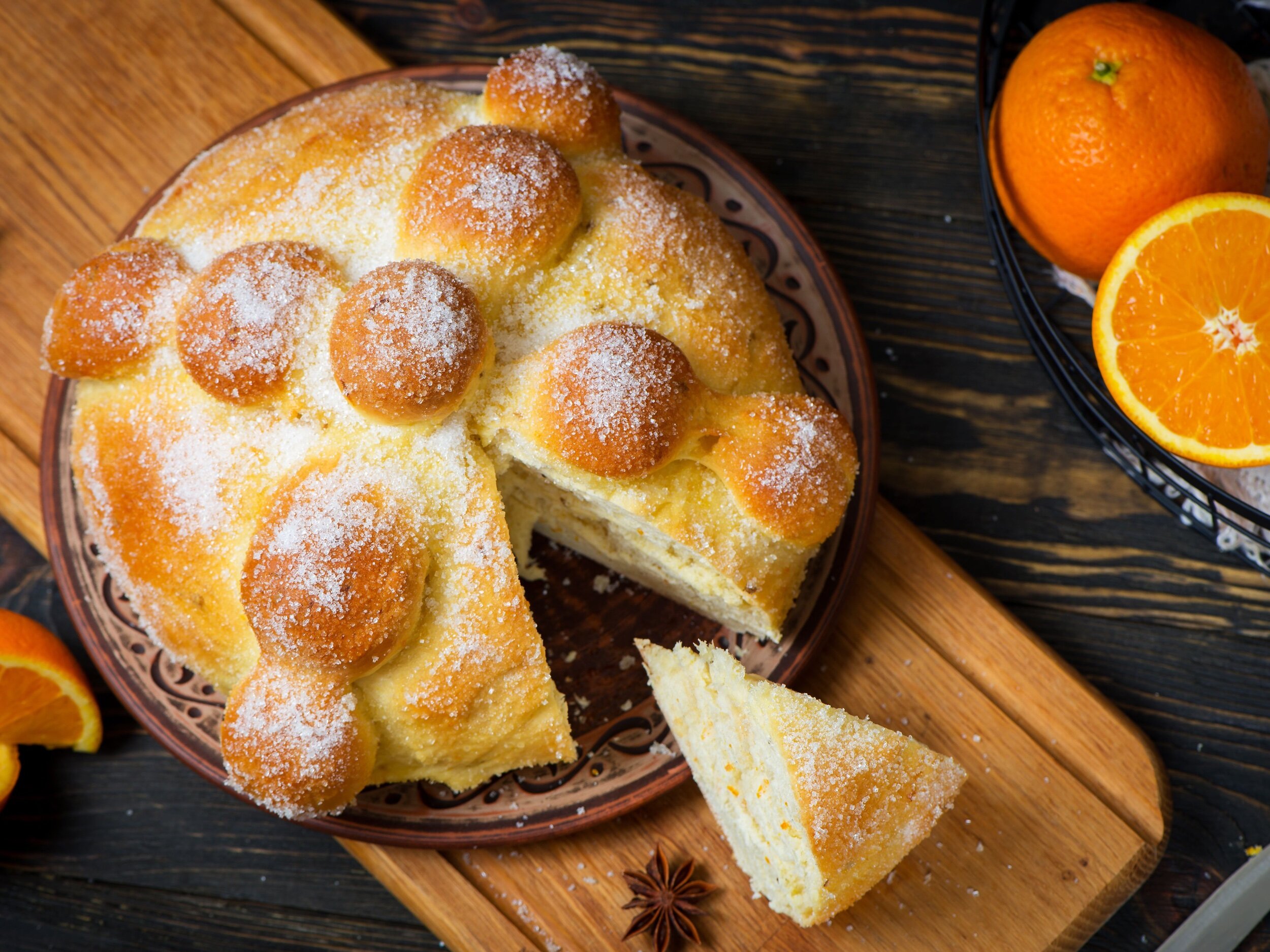Bread Around the World
Author: Arushi Mukherjee
Bread is a staple in cultures around the globe. It serves as a pairing, appetizer, main dish, or dessert. Bread nourishes us while also reflecting the tenets of a community – the method, flavor, and history of the deliciously carb-filled treat all convey the characteristics of a culture. Breadforms the backbone of almost every cuisine, and its versatility is clearly seen on a short trip around the world.
1. Mexico: Pan de Muertos
https://www.thespruceeats.com/pan-de-muerto-2343007
We start close to our home in North America: Mexico. Pan de Muerto, or Day of the Dead bread, is a traditional Mexican sweet bread. The bread is slightly sweet and spongey, with hints of organe, anise, and floral tones, topped with sugar or sesame seeds. It is usually made, as its name suggests, for Day of the Dead (or Dia de los Muertos) at the end of October. For Dia de los Muertos, Mexican families honor their deceased ancestors and leave offerings of things they enjoyed in their lives at either the ancestor’s grave or at homemade altars. A loaf of Pan de Muerto is included in this offering made, cementing its important role in the day and culture. Pan de muerto is typically shaped in a round loaf, with pieces forming a cross on top, symbolizing the deceased’s bones, and a small ball on top, which some say represents a skull and others say represents a tear or heart.
2. Brazil: Pao de Queijo
https://www.thespruceeats.com/pao-de-queijo-brazilian-cheese-bread-3028981
Our next stop on the tour is Brazil, with its famous Pao de Queijo, or cheese bread in English. The bread is a small roll with cheese baked into it, and it originates in the state of Minas Gerais in southeastern Brazil. The bread was originally made by slaves from cassava root and without cheese. In the 1800s, when luxury items like milk and cheese became more common, they were added to the recipe. Now, the bread is made with tapioca, which gives it its incredibly chewy texture. It boasts a richly cheesy and slightly nutty flavor. Nowadays, pao de queijo is a popular breakfast or snack dish and is commonly served as street food. The bread is also very popular in Japan, Australia, and the US.
3. South Africa: Green Mealie Bread
https://www.news24.com/you/Archive/mealie-bread-20170728-8
Moving from South America to the neighboring continent of Africa, we turn our attention to Green Mealie bread from South Africa. Despite its name, the bread is not green, but has a slight yellow tinge that it gets from its main ingredient: corn. It is sliceable and uses flour, but the dish is less like a bread than a thick and cohesive steamed corn pudding. The “green” in the name comes from the cooking method – the bread is steamed inside of green corn husks. It is traditionally eaten hot and buttered. “Mealies” is the African version of maize or corn.
4. Croatia: Povitica
https://joyfoodsunshine.com/walnut-cinnamon-swirl-bread/
From South Africa, we move far up north to Croatia to the land of Povitica, a sweet yeasted dough. The filling is most typically walnut or poppy seed. It is rolled with ground nuts and honey or other sweeteners. It can be baked into a log shape or bent into a horseshoe. The “bread” part is made from pastry dough that is rolled very thinly with brown sugar, spices, and nuts. It tastes toffee-like and almost resembles baklava. Povitica originated in Slovenia, and the fillings put in the bread reflected the background of families – wealthier families could afford more expensive ingredients like cream, nuts, or raisins, while poorer families used herbs from their backyard gardens or other accessible ingredients.
5. China: Hua Juan
https://bake-street.com/en/hua-juan-steamed-scallion-buns/
While Povitica is a sweet bread, in our next destination, we encounter a savory one: Hua Juan from China. Translated, Hua Juan means flower rolls, and they are a variation of Chinese steamed buns. They can be served during breakfast or as a part of other meals as well. The rolls consist of a yeasted dough that is filled with a filling made of minced scallions, ground Chinese five spice, and oil. The dough itself, when steamed, is fluffy and slightly chewy. The rolls are more popular in the northern regions of China. They are named after flowers because they are rolled and then swirled into small buns that resemble a rose or tightly coiled flower.
6. New Zealand: Paraoa Rewena (Maori bread)
https://www.supervalue.co.nz/recipes/rewena-bread/
On our final destination of this world tour, we land in New Zealand. Paraoa Rewena, commonly known as Maori bread, is a sourdough bread made from fermented potato rather than the traditional yeast, giving the bread a firmer texture than flour or yeasted bread. It has a slightly tangy flavor and is often eaten piping hot with golden syrup, preserves, or butter. The Maori people are the indigenous Polynesian people of New Zealand, and this bread comes out of their cuisine and culture, hence its modern nickname “Maori bread.” Directly translated, Paraoa Rewena means “flour leavened.” Like sourdough, the bread uses a starter, but this starter is made from potatoes, flour, and sugar. After fermenting for several days, it is used to make the dough, giving the bread a characteristically sweet and sour taste, usually baked in a round loaf.
While a seemingly mundane aspect of cuisine, bread is versatile and universally binding. It is found in all corners of the world and connects people over continents. So, next time you make yourself toast, think about what bread really means to you and your community!






